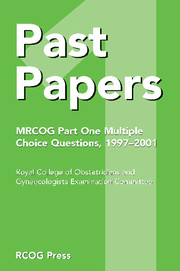Book contents
- Frontmatter
- Contents
- Introduction
- March 1997 – Paper 1
- March 1997 – Paper 2
- September 1997 – Paper 1
- September 1997 – Paper 2
- March 1998 – Paper 1
- March 1998 – Paper 2
- September 1998 – Paper 1
- September 1998 – Paper 2
- March 1999 – Paper 1
- March 1999 – Paper 2
- September 1999 – Paper 1
- September 1999 – Paper 2
- March 2000 – Paper 1
- March 2000 – Paper 2
- September 2000 – Paper 1
- September 2000 – Paper 2
- March 2001 – Paper 1
- March 2001 – Paper 2
- September 2001 – Paper 1
- September 2001 – Paper 2
- Index
September 2001 – Paper 1
Published online by Cambridge University Press: 05 July 2014
- Frontmatter
- Contents
- Introduction
- March 1997 – Paper 1
- March 1997 – Paper 2
- September 1997 – Paper 1
- September 1997 – Paper 2
- March 1998 – Paper 1
- March 1998 – Paper 2
- September 1998 – Paper 1
- September 1998 – Paper 2
- March 1999 – Paper 1
- March 1999 – Paper 2
- September 1999 – Paper 1
- September 1999 – Paper 2
- March 2000 – Paper 1
- March 2000 – Paper 2
- September 2000 – Paper 1
- September 2000 – Paper 2
- March 2001 – Paper 1
- March 2001 – Paper 2
- September 2001 – Paper 1
- September 2001 – Paper 2
- Index
Summary
1. The vagina
A. is lined by squamous epithelium.
B. is supplied in part by the uterine artery.
C. is covered with peritoneum in its upper anterior aspect.
D. has venous drainage to the external iliac vein.
E. is supplied in part by the pudendal nerve.
2. The following muscles are inserted into the perineal body:
A. bulbospongiosus.
B. ischiocavernosus.
C. obturator internus.
D. external anal sphincter.
E. superficial transverse perineal.
3. In the abdominal wall
A. the rectus abdominis muscle is attached to the crest of the pubis.
B. the posterior border of the external oblique muscle ends in the linea semilunaris.
C. the aponeurosis of the external oblique muscle takes part in the formation of the conjoint tendon.
D. the inferior epigastric artery is a branch of the internal iliac artery.
E. the conjoint tendon blends medially with the anterior layer of the rectus sheath.
4. In the pituitary gland
A. the anterior lobe is smaller than the posterior lobe.
B. the posterior lobe is ectodermal in origin.
C. the acidophil cells produce oxytocin.
D. the basophil cells produce growth hormone.
E. the blood supply is derived from the internal carotid artery.
5. The pineal gland
A. is situated at the anterior end of the third ventricle.
B. is innervated by the parasympathetic nervous system.
C. produces melatonin.
D. may be calcified in the adult.
E. is most active during daylight.
- Type
- Chapter
- Information
- Past Papers MRCOG Part One Multiple Choice Questions1997–2001, pp. 182 - 191Publisher: Cambridge University PressPrint publication year: 2004



